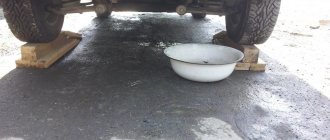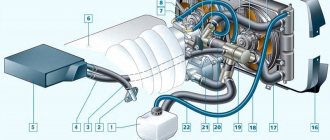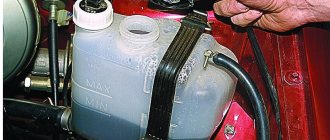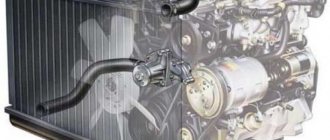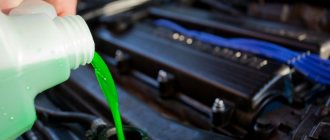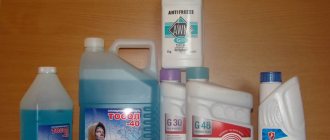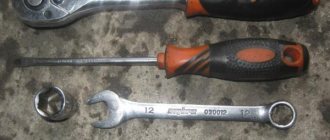Replacing the coolant: how much antifreeze to pour into a VAZ 2107
A car is one of the main means of transportation, so that its operation does not stop, it is necessary to replace the antifreeze on time. The operation of the motor depends on the correct choice and use of fluid. For a more clear explanation, we can analyze the situation that has arisen using the example of a VAZ 2107 car.
Antifreeze volume in the car
The first thing you need to know is how much antifreeze can be poured into a VAZ 2107 so that it works stably. For cars of brands such as VAZ 2101, 2105, 2106 and VAZ 2107, the volume of fluid is the same - 9.85 liters, it must be replaced every two years. Replacing antifreeze on a VAZ 2107 occurs in the following way:
- The first thing you need to pay attention to is the cooling system; if it is clogged, it needs to be washed with special products or water.
- Next, you need to take a spanner wrench and a container of at least ten liters to drain the old car fluid. It is very important that the radiator is cold when replacing, since antifreeze is a harmful substance, and when heated it also becomes very toxic.
The volume of coolant in a VAZ 2107 can reach up to ten liters. Antifreeze is suitable for the engine cooling system, as it prevents heat from entering the engine and cools the radiator. The cooled antifreeze is moved to the car engine using a pump.
This process continues until engine operation stops. During operation, antifreeze heats up and loses its positive properties, so it must be changed periodically. The process of heating the antifreeze occurs when the car travels a distance of about 60 thousand km.
kilometers.
Methods for replacing antifreeze
Many beginners do not know how to drain antifreeze from a VAZ 2107. Since it is a toxic substance, it must be treated with extreme caution, and it is better to adhere to general safety rules. Immediately before draining the liquid from the car, you need to prepare some kind of container or simply use an unnecessary basin . The following steps are followed:
- To begin with, the car is put on the handbrake, then a container is placed under the engine to drain the used fluid.
- Then you need to open the hood, find the expanded tank and unscrew the cap so that the pressure drops. Such actions are carried out to speed up the process.
- The lid on the radiator also opens.
- The lid on the stove opens from inside the car. To drain the remaining antifreeze, you need to set the lever to the warm position.
- The next step is to unscrew the bolt plug from the cylinder, or rather, from its lower part.
- Then the cap on the radiator drain hole is opened.
- The antifreeze begins to gradually flow into the container, the process of its release takes about ten minutes.
- Afterwards, you need to make sure that all the liquid has come out; if anything remains, it needs to be drained.
In order to correctly fill the liquid and it does not leak out, you need to check the integrity of the pipe. If the pipe is damaged even slightly, it should be replaced. Replacing the coolant in the injection VAZ 2107 is carried out as follows:
- First, you need to unscrew the sensor between the third and fourth spark plugs to prevent air locks from appearing in the cooling system.
- The solution must be poured through the hole located in the radiator; it must be poured until everything is filled. The volume here reaches five liters.
- The sensor turns on, but the antifreeze continues to fill.
- The liquid must be filled completely until the radiator is filled to the brim.
- When the entire procedure is completed, the radiator is closed with a lid. The remainder is added to the cooling system in the expanded tank to the maximum mark.
The operation of the injector depends on the system of installed devices and temperature sensors. All screwing of the lids can be done with a simple thirteen key. Why do you need antifreeze:
- Maintaining engine temperature during operation.
- Maintaining a low temperature of the liquid in the automatic transmission.
- For heating the interior. The liquid provides heat to the car by circulating through the heater. The motor heats the liquid, and the fan moves the heat into the cabin.
Lack of fluid and consequences
The disadvantage of antifreeze is rapid evaporation; you also have to solve the problem of leakage. It happens that liquid can be seen leaking under the car. There are also cases when it goes into the car interior, this indicates a breakdown of the heater taps, they need to be replaced.
In addition, smoke may be emitted from the exhaust pipe. This occurs due to a faulty cylinder head gasket. When antifreeze boils, you need to fix the problem in time ; you need to drain it and change it.
Source: https://zapchasti.expert/zhidkosti/ohlazhdayushhie/zamena-oxlazhdayushhej-zhidkosti-skolko-tosola-lit-v-vaz-2107.html
Leaks and problems
Cars of this model sometimes have problems associated with the failure of some parts of the cooling system, such as a thermostat or pump.
If they break down, they are replaced as an assembly, fortunately they are not expensive. Also, leaking hoses or a cracked expansion tank are considered a common problem, which also needs to be replaced. But there is another problem with the VAZ 2106, a leaking heater valve. Because of this, there may be a smell of antifreeze in the cabin, wet floor mats on the front passenger side, or the heater may not work.
In cases of boiling or seething antifreeze in the expansion tank, you need to pay attention to 2 things. This is either an air lock or a broken cylinder block gasket.
When determining the problem, in the first case the stove will blow cold. In the second case, there will be either oil in the antifreeze or light smoke from the exhaust pipe.
The amount of antifreeze in VAZ 2106
The technical specifications for any car indicate the volume of coolant that must be poured into the expansion tank for the normal operation of all systems and mechanisms. Let's find out how much antifreeze a VAZ 2106 will need to ensure uninterrupted engine operation.
What is coolant
First of all, you need to decide on the type of cooler, since the VAZ 2106 is filled with antifreeze and antifreeze. For this purpose, let's look at some of the differences and similarities between coolants.
Antifreeze
- this is the development of Soviet scientists and almost every second person is accustomed to calling any cooler this way. It consists mainly of water, ethylene glycol and additives of mineral origin.
This cooler can be mainly used in engines made of heavy metal alloys
, since the property of forming films on the internal parts of the engine and the system as a whole has a detrimental effect on aluminum parts.
Antifreeze almost does not protect against corrosion and it also tends to form sediment, which, when accumulated, clogs narrow hoses.
Antifreeze
- this is already a development of foreign automakers, which with each new type they are trying to improve, make it better and safer for the engine.
Antifreezes exist in the following classes: G11, G12, G12+, G12++, G13.
They also contain water and ethylene glycol, but the additives are of a higher quality and each class of coolant can be distinguished by color.
But, let’s say, the G11 class is similar in composition and quality indicators to the domestic cooler, so you can safely interchange them.
How to replace antifreeze in a VAZ 2106
Before you start replacing the cooler, you need to know how many liters of antifreeze to pour into the VAZ 2106, how best to do this so as not to cause harm, what type of liquid to choose so that it fits your car’s engine as best as possible.
Only after you have clarified all these points can you begin to replace the antifreeze or antifreeze yourself. But, if you are still not confident in the thoroughness of your knowledge, then it is better to contact qualified specialists at a service station.
Procedure for replacing antifreeze
So, having clarified all the necessary points, we found out that in the VAZ 2106 the volume of coolant is about ten liters
, so you need to take exactly ten liters of coolant. Before use, the concentrate must be diluted according to the instructions or purchased ready for use.
Coolant replacement steps:
- Check the sensor, which is responsible for the qualitative and quantitative indicators of antifreeze in the system.
- Drain off any remaining old antifreeze. To do this, you need a container into which the waste material will drain.
- Make sure that the engine has completely cooled down, because if this does not happen, you can easily get a serious burn.
- Place the car on a slope to better drain all unnecessary liquid.
- Unscrew the plugs and bolts from the radiator and expansion tank.
- Be sure to rinse the entire system several times with water or special products. This is primarily necessary when you want to use another type of cooler.
- Fill with new antifreeze and turn on the engine. Let it work for a while.
- Now you can check the sensor readings, temperature and how much antifreeze is in the tank. If the quantity is insufficient, you can add antifreeze to the required level.
- Tighten all the plugs and bolts and the car is ready for further use.
To fill in a new substance
In order to replace the antifreeze with a new one, you need to return the radiator tank to its original place and tighten the drain plugs and the neck of the part. After this, new coolant should be poured into the radiator and its expansion tank, but slightly more than the minimum mark. An equally important action is to neutralize all air pockets formed in the cooling system.
After closing the radiator, you can start the car and let it idle for about five minutes. After the engine has cooled down, it is necessary to add antifreeze to the maximum level.
.
Cooling system of the VAZ 2106: Diagram, How much antifreeze, Malfunctions, How to ventilate
Table of contents
Diagram How much antifreeze is in the system Air lock Malfunctions How to rinse How to ventilate Replacing pipes
Scheme
How much antifreeze
Airlock
Malfunctions
| Malfunction | Cause | Remedy |
| Liquid leak from the cooling system. | Leaking fluid from the heater tap. | Replace the tap. |
| Hose clamps are not tightened properly | Tighten the clamps. | |
| Fluid leaking from the pump. | Replace the pump. | |
| The radiator is damaged. | Replace the radiator. | |
| The gasket in the cylinder head is damaged. (Coolant enters the engine, sometimes thick white smoke is visible when the engine is running). | Replace gasket | |
| Engine overheating. | Liquid leak from the cooling system. | Eliminate the malfunction and restore the fluid level in the system. |
| An air lock in the engine cooling system (can form when replacing the coolant or when air is sucked in at the hose attachment points). | If there is air suction, eliminate it, then, with the expansion tank cap open, start the engine and wait until air bubbles stop coming out of the expansion tank, adding coolant if necessary. | |
| The surface of the radiator is dirty. | Clean the radiator. | |
| The radiator is faulty. | Replace the radiator. | |
| Thermostat is faulty. | Replace thermostat. | |
| The pump is faulty. | Replace the pump. |
How to rinse
Flushing the cooling system with water
Although it is possible to flush the system with water, I would strongly advise against it. As I already said, it contains a large amount of impurities and salts that form scale. If there is no other option, then at least use distilled water. Flushing the cooling system using distilled water is done as follows:
Pour water into the SOD.
Start the engine and let it run for about half an hour.
Then turn off the engine and drain the water from the system. Repeat the procedure until your flushing fluid is the same as before flushing. The disadvantages of this method include: scale formation, low efficiency (boiling water is not able to dissolve and wash scale and other deposits).
Flushing the cooling system with water, acid and vinegar
Water with vinegar and acid is a little better than just water, because thanks to acids you can remove scale and partially clean the cooling system. In order to flush the system using this method, prepare: caustic soda, lactic acid and vinegar.
The acid is added carefully and a little at a time; if you overdo it, you can say goodbye to the plastic and rubber parts of the cooling system. To completely remove scale and dirt, it takes 5-10 hours, during which it is necessary to periodically warm up the engine to operating temperature.
At the end, all the liquid is drained and distillate is poured in, which is used for the final flushing of the cooling system.
Washing SOD using special chemicals
Specialist. means are the most effective and expensive option. However, the effectiveness of such a procedure is worth the overpayment. Cleaning products contain special cleaning agents that actively remove scale, grease, organic matter, etc.
Flushing specials products are divided into four types: acidic, alkaline, two-component, neutral.
Acid and alkaline are considered the least popular; moreover, they are almost impossible to find undiluted. This is explained by their aggressive effect on the entire cooling system, essentially plastic and rubber products.
Two-component products are very popular and in great demand. Their 2-component solution consisting of alkali and acid copes well with the task. Each of the components is poured into the radiator in turn.
Neutral cooling system cleaning products do not contain aggressive substances, such as acids or alkalis, and are used exclusively for preventive purposes.
How to de-air
Replacing pipes
Source: https://vz06-up.ru/sys-oh/sistema-ohlazhdeniya-vaz-2106.html
Replacement frequency, what antifreeze to fill
According to the manufacturer's recommendation, it is necessary to replace antifreeze or antifreeze on VAZ 2106 cars every 2 years or after a mileage of 60 thousand kilometers. If the car is used in more severe conditions, then it is advisable to replace it more often - every 30-40 thousand kilometers.
- Loss of properties. You can check the quality of the antifreeze used using a test strip, which is sold in the same places where the liquid itself is sold. Place the strip in the expansion tank, then pull it out. The strip comes with a color scale, according to which you can understand how much longer the car can be used before replacing the coolant.
- Change in color to red or red. This means that rust has appeared in the composition.
- The appearance of sediments, flakes and dense formations.
In all cases, it is necessary not only to replace, but also to check the entire engine cooling system for serviceability.
As a coolant for the VAZ 2106, you can use good Lukoil antifreeze. Or a lesser-known but high-quality product from Gazprom Neft. When replacing, you can also fill in antifreeze, preferably with G12 approval, it is safer for the entire system. You can also use original Lada G12 antifreeze, which is suitable for all cars of this manufacturer.
How much antifreeze is in the cooling system, volume table
Cooling system VAZ 2107: device and diagram
Movement is life, but movement is warmth. Try rubbing your palms together and see for yourself. Heat is the final transformation of all energies into each other. In the human body, mutual transformations of proteins, fats, and carbohydrates occur, which as a result decompose through multi-stage enzymatic oxidation with the release of heat.
In the heart of a car engine, chemical transformations of fuel into exhaust gases and water also occur, releasing a large amount of energy, which is converted into mechanical energy, and some is dissipated as heat. Moreover, this heat must be purposefully collected and removed, no matter how much of it is generated.
This is precisely what the cooling system of the VAZ 2107 serves for.
If we remember that the efficiency of a gasoline engine is ideally 25%, and in city traffic jams - about 7%, this means that out of a 40 liters of a fully filled VAZ 2107 tank in city conditions, you spent only three liters on moving the car! How many? We repeat, three liters, we were not mistaken. Where did the other thirty-seven go? That's right, they burned in a useless fire, polluting the air and wearing out the car. The carburetor and injector improve efficiency, but not much. The cooling system of the VAZ 2107 is responsible for removing this heat.
The engine cooling system diagram is as follows:
Structure of the main parts of the system: (in the picture there is a VAZ 2106 engine on which a carburetor is installed).
- The actual jacket of the engine cooling system (7), passages and holes in the cylinder block, with its exhaust pipe (4).
- The cooling system pump, or pump (16), during the operation of which coolant (antifreeze, antifreeze) circulates. Its structure is similar to an impeller. It is in a single connection with the generator, a single belt (15).
- Thermostat (18) separates the small (when the engine is cold) and large (when the engine is hot) fluid circulation circles. The thermostat device is simple; its task is to open or close the liquid bypass valve.
- Cooling system hoses (discharging cooled liquid from the radiator and supplying hot liquid to the radiator, thermostat hoses, hoses to the pump, etc.).
- The radiator is the main heat exchanger with a cooling function. The design of the radiator can be different; now aluminum is used, but a copper radiator is much more efficient, but less resistant.
- Radiator fan, commonly known as “Carlson” (11), which turns on if necessary when the engine temperature rises.
- Expansion tank available for visual control of fluid quality and topping up. A durable hose runs from the expansion tank to the radiator neck. Some people think it's a coolant hose, but that's wrong. Its function is simply to keep the radiator filled.
A complete cooling system diagram includes additional parts such as drain plugs, fan switch, fan fuse, and others.
Let us remind you that on the VAZ 2107 the electrical circuit is such that the fan and sound signal fuse is one common, 10 A.
This means that if you beep too much when the fan is running (and this can be easily noticed by the slight noise and increased charge consumption), you risk being left with an overheated engine.
The total volume of the cooling system on the VAZ 2107 is 9.85 liters. Inexperienced drivers sometimes find it impossible to fill more than 3-5 liters; this is hampered by air pockets that need to be removed. The volume of plugs can be half the volume of the entire system! The container is designed for a completely filled jacket, hoses, radiator, and expansion tank.
In the cooling system, the freezing point of antifreeze should not be higher than -40 degrees Celsius.
People often ask: injector and carburetor - is there a difference in the cooling system? Yes, there is, but it is insignificant.
Heat removal mechanism repair
Before you begin repairing the cooling system, you need to find out the volume of liquid poured into it. But even completely draining the old antifreeze, it will not be possible to fully establish the exact figure. To do this, it is still recommended to refer to the vehicle’s operating manual, where all the necessary regulations and parameters are indicated.
The manufacturer assures that the working volume of the VAZ-2106 engine cooling system is nine liters, but it is worth considering that you need to add about a liter to this volume in order to add antifreeze to the expansion tank to the minimum mark. In addition, a thrifty and prudent driver must have a spare liter container of coolant in the trunk.
It turns out that before replacing the cooler or repairing the entire system, you should purchase about eleven liters of antifreeze. However, when making repairs, you can save a little by leaving most of what you bought in reserve.
Cooler drain
Before any operation on the cooling system, you must first allow the engine to cool to avoid serious injury.
Then the liquid filling the system will need to be drained. To do this correctly, you have to figure out how it works. The cooling system has two stages of operation. They can be called cycles and divided into two circles:
- Big.
- Small.
The small circle is limited by the engine itself and some pipes, and it is intended to ensure that the engine quickly reaches the temperature necessary for proper operation. This is important so that the fuel mixture burns more efficiently with a higher efficiency. When the temperature rises to a certain point, a special valve opens, releasing liquid in a large circle. The purpose of this cycle is to directly cool to an acceptable temperature.
The large circle includes a radiator with a fan, which is turned on by a special thermostat and the air flow cools the system and the engine. All liquid is driven by a pump or pump. It also creates the required pressure in the cooling system.
First of all, the antifreeze is drained from the large circle through the radiator, in the left corner of which there is a special drain valve. To do this, you need to prepare a special container with a wide neck. Then a special plug is unscrewed from the engine itself and drainage occurs from the small circle, that is, directly from the engine.
If necessary, all pipes are removed, which need to be changed if necessary, but if they do not have visible damage, cracks or leaks, then you can also save money on this. After all the liquid has drained, the necessary repairs are made.
Correct refilling with antifreeze
After completing the necessary work, all drain holes are closed, and the pipes are put in place, and the VAZ-2106 antifreeze is replaced. The liquid that was drained into the container can be reused by carefully filtering it through cheesecloth before doing so. The cooling system is refilled through the expansion tank.
You should try to pour the liquid carefully, without spilling it on the body, in order to avoid subsequent corrosion. When the liquid stops being absorbed, you need to warm up the engine to the maximum temperature at which the damper opens, releasing antifreeze in a large circle.
Before refueling, it is necessary to measure the required amount in order to control the filling of the system. After the engine warms up, the liquid will again leave the expansion tank, which will mean filling a large circle with antifreeze. Next, all that remains is to add the missing liquid to the minimum mark. Overflowing above the level is not recommended , since when heated, the antifreeze expands, and the pipes or expansion tank may not withstand the pressure created by the pump! After refueling is completed, you must ensure that the cooling system is tight and there are no leaks.
The operation of replacing the coolant in a VAZ-2106 is not that complicated, but it will help you save some time, money, and most importantly, you will have confidence that the work was done efficiently.
How much antifreeze should be poured into a VAZ
Antifreeze is necessary to ensure that the car engine does not overheat and operates correctly in any climatic conditions. Antifreeze is poured into the vehicle's cooling system. Before this, of course, you should drain the old fluid. Each car model has its own volume of antifreeze that must be poured inside.
Antifreeze should be filled to the maximum mark on the expansion tank
Each VAZ model has its own permissible coolant volume limit. This limit should never be exceeded, otherwise antifreeze will begin to splash out of the expansion tank, which can lead to overheating of the engine.
So, how much antifreeze needs to be poured into the VAZ model:
- The VAZ 2107 is filled with 9.85 liters
- The VAZ 2109 is filled with 8.7 liters
- The VAZ 2114 is filled with 7.8 liters
- The VAZ 2110 is filled with 7.8 liters
For the VAZ 2109 model, antifreeze replacement is required after sixty thousand kilometers, or once every two years. Replacement is carried out only on a cold engine. This precaution is due to safety measures, since hot antifreeze can cause severe burns to a person.
How to fill in new coolant
These instructions for filling antifreeze are intended for the VAZ 2109 model. But other VAZ models have a similar replacement scheme.
VAZ instructors recommend using AM and A40M antifreeze for models 2109.
In the event that it is impossible to use an inspection hole, as an option, the car owner can be advised to purchase special taps that are installed instead of drain plugs.
A hose is attached to these taps, and the liquid already circulates through it. This device greatly simplifies the process of replacing coolant.
Work on replacing antifreeze is carried out only on a cold engine.
So, to fill in antifreeze, you need to do the following:
- First, you need to tighten the drain plug located on the radiator. You also need to remove the plug from the cylinder block.
- We untie the clamp of the antifreeze outlet hose and disconnect it from the throttle fitting
- Then you need to hold this hose with your hand
- We pour new antifreeze into the tank. You need to fill about four to five liters
- Return the hose to the fitting again
- Tighten the clamp on the hose
- Again you need to pour antifreeze into the expansion tank. You need to pour until the liquid reaches the maximum mark. In total, about seven to eight liters of antifreeze should be spent
- Next you need to put the tank cap back in place.
- Then return the ignition module
- You should start the car and warm up the engine to operating condition.
- Next, turn off the engine and again you need to measure the antifreeze level
- If the coolant level does not reach the maximum level, then you need to add more antifreeze.
When pouring antifreeze, several important points should be taken into account:
- As already mentioned, all work should be carried out exclusively with a cooled engine.
- When draining the coolant, there is a risk of moisture entering the generator. To prevent this from happening, the generator must be protected before draining.
- Be sure to check the antifreeze level after running the engine. If the fluid is below the maximum mark, then over time the engine will begin to overheat, which can accelerate the process of wear and tear.
- It is not recommended to allow antifreeze and antifreeze to mix. Liquids differ in composition, so the quality of their work when mixed will be significantly reduced
Source: https://avtoedet.ru/skolko-tosola-neobkhodimo-zalivat-v/
How to drain and replace antifreeze on a VAZ?
Replacing antifreeze in the engine cooling system is an event that is performed at certain intervals in order to maintain efficient operation of the cooling system. Today you will learn how to drain and change antifreeze on a VAZ 2107 and why this is done.
Why do they change antifreeze?
The cooling system of many modern cars is liquid.
That is, heat transfer is carried out by a liquid that circulates through a system of tubes and, cooling in the radiator, returns back to the engine to receive a new portion of heat.
The VAZ 2107 engine cooling system initially used water, but later, due to reduced resistance to negative temperatures, it was replaced with antifreeze.
Antifreeze, compared to water, has good resistance to frost and does not freeze at all. In addition, it is not a source of scale, which means it does not clog the cooling system.
In the process of constant temperature exposure, antifreeze may lose its properties. That is, first of all, its boiling point decreases and becomes equal to the boiling point of ordinary water.
Secondly, such fluid can easily freeze and cause a cracked reservoir, and in the worst case, a cracked cylinder block.
That is why antifreeze must be changed at least once every six months during seasonal vehicle maintenance in order to avoid undesirable consequences.
How to drain antifreeze correctly?
In order to drain the antifreeze, it is not enough to simply turn off the taps. To begin with, you need to understand that antifreeze is a toxic substance, which means it can pose a danger to humans if handled incorrectly. In this regard, there are a number of rules that must be followed:
- Under no circumstances should you drain antifreeze onto the floor in your garage or yard . Since this substance is toxic, its fumes can enter the human respiratory system. Do not underestimate the chemical composition of antifreeze. After all, one glass of such “muck” can easily kill a person.
- As you already understand, you should not allow antifreeze to get into your mouth. Many drivers do a very dangerous test when determining the type of liquid poured into the expansion tank: they dip their finger into this tank and then try it with their tongue. If it was sweet, then it is 100% antifreeze, and if not, and it gives off scale, then it is the most ordinary water, which has already been overheated more than once.
- If antifreeze gets into your eyes, hands or other parts of the body, be sure to rinse these areas under running cold water and call a specialist doctor. Do not forget that antifreeze is, first of all, poison for humans, and only then a coolant for the engine.
- After completing work related to repairing the cooling system, you must thoroughly wash your hands. In addition, it is strictly prohibited to eat anything while performing this work.
To properly drain the antifreeze, you need to prepare an empty container with a capacity of at least 10 liters. The most desirable condition is the presence of a wide cavity and not a deep bottom. The fact is that there is not enough space under the car in height, but there is enough width. That is why many drivers use the most ordinary aluminum trough for these purposes.
Principle of operation
Correct draining of antifreeze from a VAZ 2114
The main place in a car is not the driver’s seat or even the steering wheel, but the engine. It is even called the heart. And this is not without reason, because the correct functioning of this heart directly determines whether the car will go or not. And in order not to destroy such an important technical unit, it is necessary to maintain a certain temperature and cool it in time.
The operating principle of this system is quite simple, but at the same time technically well thought out. It is connected by pipes to the engine itself, the radiator and the interior heater
To understand the importance of these elements, you need to know their main functions:
- Maintaining the required temperature.
- Engine cooling.
- Warming up the car interior.
In the first case, for engine operation and proper combustion of the fuel mixture, a certain and stable temperature is required. If it is higher or lower, it has a very bad effect on the engine. In the second case, the engine is protected from overheating, which can lead to deformation of some parts inside.
If you exclude the last item from the list, then operating the car will become impossible in cold weather. And a key role in this system is played by a special liquid, without which the presence of a cooling cycle would be meaningless.
Types of coolants
To absorb heat and remove it from hot spots in the engine, the system requires coolant. There are several types of cooling liquids:
But in the harsh realities of the Russian climate, the use of water as a coolant is impractical. And it boils away very quickly, having a rather low thermal conductivity. You don’t even need to mention how it affects the occurrence of corrosion.
Antifreeze is the most common among domestic car owners, but it has some disadvantages, for example, the formation of an oil film inside the vessels and pipes, which prevents normal heat transfer. Accordingly, heat removal becomes ineffective.
The third option has more pros than cons. Firstly, antifreeze begins to crystallize at very low temperatures, that is, it does not freeze, which is why it got its name. This advantage allows the use of antifreeze even in the Far North. Secondly, the thickness of the oil film formed inside the vessels is very small, thanks to which almost nothing interferes with the transfer of heat. This is achieved due to the fact that antifreeze, unlike antifreeze, is made from organic components.
The main disadvantage of antifreeze is its price, especially if you need to replace the entire fluid. Antifreeze wins here, and it is more rational to use it in car models such as the VAZ-2101 or VAZ-2106. In models of the domestic automobile industry with impressive age and mileage, the cooling system often becomes a sore and vulnerable spot. Therefore, the owners of these cars need to know the principle of operation of the cooler and understand how to repair it, which will help avoid spending on services and auto repairmen.
